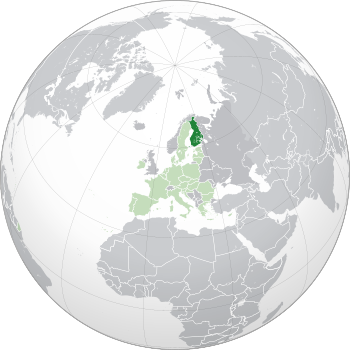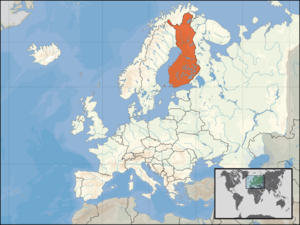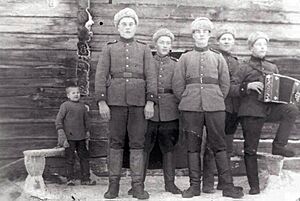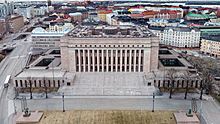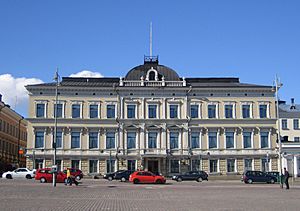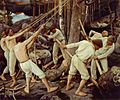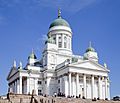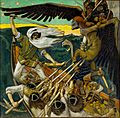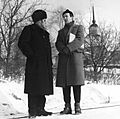Finland facts for kids
Quick facts for kids
Republic of Finland
|
|
|---|---|
|
Location of Finland (dark green)
– on the European continent (green & dark grey) |
|
| Capital and largest city
|
Helsinki 60°10′15″N 24°56′15″E / 60.17083°N 24.93750°E |
| Official languages | |
| Recognized national languages |
|
| Ethnic groups
(2023)
|
|
| Religion
(2023)
|
|
| Demonym(s) |
|
| Government | Unitary parliamentary republic |
| Alexander Stubb | |
| Petteri Orpo | |
| Jussi Halla-aho | |
| Legislature | Parliament |
| Independence
from Soviet Russia
|
|
| 29 March 1809 | |
|
• Declaration of independence
|
6 December 1917 |
|
• Constitution established
|
17 July 1919 |
| Area | |
|
• Total
|
338,145 km2 (130,559 sq mi) (65th) |
|
• Water (%)
|
9.71 (2015) |
| Population | |
|
• 2023 estimate
|
|
|
• Density
|
18.4/km2 (47.7/sq mi) (213th) |
| GDP (PPP) | 2023 estimate |
|
• Total
|
|
|
• Per capita
|
|
| GDP (nominal) | 2023 estimate |
|
• Total
|
|
|
• Per capita
|
|
| Gini (2023) | low |
| HDI (2022) | very high · 12th |
| Currency | Euro (€) (EUR) |
| Time zone | UTC+2 (EET) |
|
• Summer (DST)
|
UTC+3 (EEST) |
| Date format | dd.mm.yyyy |
| Calling code | +358 |
| ISO 3166 code | FI |
| Internet TLD | .fi, .axa, .eub |
Finland (Suomi in Finnish) is a cool country in Northern Europe. It is a member of the European Union and one of the Nordic countries. Finland is located between the 60th and 70th latitudes North. It shares borders with Sweden to the west, Norway to the north, and Russia to the east. To the south, across the Gulf of Finland, is Estonia. Much of Finland's coast is along the Baltic Sea.
The capital of Finland is Helsinki. The money used in Finland is the euro (EUR). Before 2002, they used the markka. Finland has about 5.6 million people. Finnish and Swedish are the official languages. Most people speak Finnish. About six percent speak Swedish, especially in western Finland and on the Åland Islands. Finland became independent from Russia in 1917.
Some of the most important cities in Finland are Helsinki, Espoo, Tampere, Vantaa, Turku, and Oulu.
Finland is a highly developed country with strong industries. Its main products are paper, steel items like machines, and electronics. The famous mobile phone company Nokia started in Finland, named after a small town. Finland has often been ranked as one of the least corrupt countries in the world.
Contents
People and Culture
The people of Finland are called Finns. Most Finns speak Finnish. About 6% of Finns speak Swedish as their first language. Finns also learn English and Swedish in school.
Many Finns work in services, like shops, banks, or offices. Others work in factories. Finns often enjoy saunas and spending time in nature. Many families have summer cottages. These are small houses where they go to relax during holidays.
The most important festivals in Finland are Midsummer and Christmas. Santa Claus is an old Finnish tradition.
Sports and Activities
Popular sports in Finland include ice hockey, skiing, track and field, and association football (soccer). Finns have also done well in swimming, motor sports, and gymnastics.
Sami People
There is a small group of people called Samis (or Lapps) in northern Finland, in a region called Lapland. Most Samis live in Norway and Sweden. Many Sami people raise reindeer. In the past, Samis were hunter-gatherers and nomads. Today, they live in regular houses.
Only about 2% of people in Finland are from other countries. However, the number of foreigners in Finland has been growing quickly.
Nature and Weather
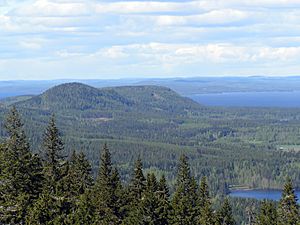
Most of Finland is covered by pine forests. The swan is the national bird of Finland. Wood is a very important natural resource. About one-third of all wood in the European Union comes from Finland.
The national animal of Finland is the brown bear. The largest animal is the elk, which is a type of moose.
Finland has hundreds of rivers and thousands of fresh water lakes. Fishing is a popular sport. There are almost 180,000 lakes in Finland!
Many islands in the Baltic Sea belong to Finland. Thousands of islands are part of the Åland archipelago. Tourists visit Lapland to see the fells (small mountains) and the amazing northern lights.
The highest point in Finland is Halti, which is 1328 meters tall. The largest lake is Saimaa, covering 4,400 square kilometers. The longest river is Tornionjoki. The largest river by water flow is Kemijoki, which is 552 kilometers long.
Seasons and Climate
Finland's weather changes a lot with the seasons. Summer usually lasts from May to early September. Temperatures can reach up to +35 °C. Autumns are often dark and rainy.
Winter snow usually starts in Helsinki in early December. In Lapland, it can snow as early as October. Winter temperatures can drop to -30 °C. Winter usually lasts until mid-March in Helsinki, but in Lapland, snow might not melt until early May. Spring lasts until late May. Spring weather can be unpredictable, changing from frost to sunshine in a few days. The famous Northern Lights are common in Lapland.
History of Finland
People first arrived in Finland about 10,000 years ago. This was after the last ice age, when a huge glacier melted away.
Some believe the first people in Finland already spoke a language similar to modern Finnish. We know for sure that an early form of Finnish was spoken during the Iron Age (2,500–800 years ago).
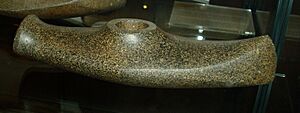
The first people in Finland were "hunter-gatherers," meaning they hunted animals and gathered plants for food. About 5,200 years ago, some people started farming crops. Farming slowly became the main way of life until modern times.
Ancient Finns were pagans, believing in many gods, like most Europeans back then. Their most important god was Ukko, the god of sky and thunder. He was similar to Odin in Scandinavia or Zeus in ancient Greece.
Around a thousand years ago, Finland, like much of Europe, started to adopt Christianity. During the Reformation in the 1500s, most Finns became Protestants. Some old pagan traditions, like bear worship, still exist in some ways.
From Sweden to Russia
From the Middle Ages, Finland was part of Sweden. Then, in 1809, Russia took Finland from Sweden. Finland became a part of Russia, but it was given special rights. This meant Finns could mostly control Finland, even though the Russian Tsar was officially in charge. They could make their own laws, had their own money (the markka), and their own stamps. However, Finland did not have its own army.
Independence and Wars
On December 6, 1917, Finland became independent from Russia. This happened after a communist revolution in Russia. Some people in Finland also tried to start a communist revolution, which led to the Finnish civil war. The communists lost, and Finland remained a capitalist country.
Later, Stalin, the leader of the Soviet Union (which Russia was part of), wanted Finland to become a communist state and join the Soviet Union. Finland's leaders refused. The Soviet Union sent many troops across the border, starting the Winter War. Finland lost some areas along its eastern border to the Soviet Union.
When Adolf Hitler of Germany wanted to invade the Soviet Union, Finland joined Germany in 1941. This part of World War II is called the Continuation War in Finland. Finland wanted to get back the areas it had lost. Finland was not a fascist country; Finns wanted freedom, not dictatorship.
As Germany started losing the war, Finland made peace with the Soviet Union. Finland had to give up the areas it had taken back. After this, Finland and Germany became enemies. Finns fought the Germans, who retreated to Norway, burning down Lapland as they went. This was called the War of Lapland. Finland remained independent.
Modern Finland
After the war, many factories were built in Finland. Many people moved from farms to cities. Factories made products like paper and steel. More and more people started working in advanced jobs, like high technology. Many also went to universities for good education. Finland was one of the first countries where most people had Internet and mobile phones. Nokia, a well-known mobile phone company, is from Finland.
Finland joined the European Union in 1995. The Finnish currency, the markka, was changed to the euro in 2002.
Government and Politics
How Finland is Governed
The Constitution of Finland explains how the country is run. Finland is a parliamentary republic, which means people vote for representatives to make decisions. The Prime Minister is the most powerful person in the country. Citizens can vote in elections for parliament, local councils, the president, and the European Union.
The President
Finland's head of state is the President of the Republic. The President is mainly a ceremonial leader. They appoint the Prime Minister, who is chosen by the Parliament. The President also handles Finland's foreign relations, like making decisions about war and peace, but not about the European Union. The President is also the commander-in-chief of the Finnish Defence Forces.
The President is elected directly by the people for a maximum of two six-year terms.
The Parliament
Finland has a single-chamber parliament called the Eduskunta. It has 200 members and makes all the country's laws. The parliament can change the constitution, pass laws, and remove the government. Its decisions cannot be overturned by courts. The parliament is elected every four years.
Many different political parties are in the parliament, such as the Centre Party, Finns Party, Green League, and Social Democrats.
The Cabinet
After elections, different parties work together to form a new government, called the cabinet. The parliament must approve this cabinet. The cabinet is led by the Prime Minister of Finland. It includes other ministers who are in charge of different government departments. The cabinet suggests most of the laws that the parliament then discusses and votes on.
Because no single party usually wins enough seats to control parliament alone, Finnish governments are often made up of several parties working together. The leader of the biggest party usually becomes the Prime Minister.
Laws and Justice
Finland's legal system is based on civil law, similar to Swedish law. It has different types of courts. There are courts for regular civil and criminal cases, and separate administrative courts for issues between people and the government. The highest courts are the Supreme Court and the Supreme Administrative Court.
Most people in Finland trust their security institutions. The overall crime rate is low compared to other European countries. Finland is also known for having very little corruption.
Economy
Finland has a mixed economy. This means that while free markets control much of how goods are made and sold, the government also plays a role in providing services. In 2013, taxes made up 44% of the country's total income, which was one of the highest in Europe.
In 2014, services, like shops and banks, made up 70% of Finland's total income.
Some of the largest companies in Finland include Neste Oil (an oil refinery), Nokia, and two big forest industry companies, Stora Enso and UPM-Kymmene. Kesko is another large company that sells everyday goods in supermarkets.
Elections
Elections are held to choose 200 members for the Parliament of Finland. People also vote for the president of Finland, members of local town and city councils, and Finnish members for the European Parliament.
Voting is secret and direct. People vote directly for the person they want to be elected. In presidential elections, you vote for a person, not a political party. All other elections use a system where votes are counted for both individuals and parties. Everyone has the right to vote, and each person gets one vote.
Famous Finnish People
- Alvar Aalto, a famous architect.
- Valtteri Bottas, a Formula One race car driver.
- The Dudesons, a four-man stunt group with TV shows and movies.
- Akseli Gallen-Kallela, a well-known artist.
- Mika Häkkinen, a Formula One World Champion.
- Tarja Halonen, a former President of Finland.
- Tuomas Holopainen, founder of the famous band Nightwish.
- Sami Hyypiä, a football (soccer) coach and Champions League winner.
- Urho Kekkonen, a former President during the Cold War.
- Jari Kurri, a five-time Stanley Cup winner in ice hockey.
- Elias Lönnrot, who put together the national epic, the Kalevala.
- Jari Litmanen, a famous footballer.
- Carl Gustaf Emil Mannerheim, a president and military leader.
- Paavo Nurmi, a famous Olympic long-distance runner.
- Kimi Räikkönen, a Formula One World Champion.
- Jean Sibelius, Finland's most important composer.
- Teemu Selänne, a Stanley Cup winner in ice hockey.
- Linus Torvalds, the creator of Linux (a computer operating system).
- Tarja Turunen, former member of the band Nightwish.
- Ville Valo, lead singer of the band HIM.
Images for kids
-
Reconstruction of Stone Age dwelling from Kierikki, Oulu
-
An ancient Finnish man's outfit according to findings from the Tuukkala Cemetery in Mikkeli, dating from the late 13th to early 15th century.
-
Late Iron Age swords found in Finland
-
The Swedish Empire after the Treaty of Roskilde of 1658. Dark green: Sweden proper. Other greens: Swedish dominions and possessions.
-
Now in Helsinki, Suomenlinna is a UNESCO World Heritage Site. It is an 18th-century sea fortress built on six islands and a popular tourist spot.
-
Pioneers in Karelia (1900) by Pekka Halonen
-
White firing squad executing Red soldiers after the Battle of Länkipohja (1918).
-
Finnish military leader and statesman C. G. E. Mannerheim leading the White Victory Parade at the end of the Finnish Civil War in Helsinki, 1918.
-
J. K. Paasikivi and P. E. Svinhufvud, both future presidents, discuss the Finnish monarchy project in 1918.
-
Areas given by Finland to the Soviet Union after World War II. The Porkkala land lease was returned in 1956.
-
Urho Kekkonen, the eighth president of Finland (1956–1982).
-
Finland joined the European Union in 1995 and signed the Lisbon Treaty in 2007.
-
Finland is known as "the land of a thousand lakes" with about 187,888 lakes. Picture of Lake Pielinen in North Karelia.
-
The brown bear (Ursus arctos) is Finland's national animal and largest carnivore.
-
Angry Birds Land, a theme park in Tampere. The mobile game Angry Birds, developed in Finland, is a global hit.
-
The Oasis of the Seas was built at the Perno shipyard in Turku.
-
Flags of the Nordic countries from left to right: Finland, Iceland, Norway, Sweden, and Denmark.
-
The historical Tavastia Castle (or Häme Castle) in Hämeenlinna, Tavastia Proper, near Lake Vanajavesi.
-
Helsinki Central Library Oodi was chosen as the best new public library in the world in 2019.
-
Pupils at the school of Torvinen in Sodankylä, Finland, in the 1920s.
-
Auditorium in Aalto University's main building, designed by Alvar Aalto.
-
The library of the University of Eastern Finland in Snellmania, the Kuopio campus.
-
Mikael Agricola (1510–1557), Bishop of Turku, a key Lutheran reformer and the father of the Finnish written language.
-
Akseli Gallen-Kallela, The Defense of the Sampo, 1896, Turku Art Museum.
-
The Finnish composer Jean Sibelius (1865–1957) was very important in classical music.
-
The Finnish filmmakers Edvin Laine and Matti Kassila in 1955.
-
Linus Torvalds, the Finnish software engineer best known for creating the popular open-source kernel Linux.
-
Karelian pasty (karjalanpiirakka) is a traditional Finnish dish with a rye crust and rice filling. It's often eaten with butter mixed with boiled egg.
-
Paavo Nurmi lights the 1952 Summer Olympics flame.
-
Kankkunen on the Laajavuori stage of the 2010 Rally Finland.
See also
 In Spanish: Finlandia para niños
In Spanish: Finlandia para niños




